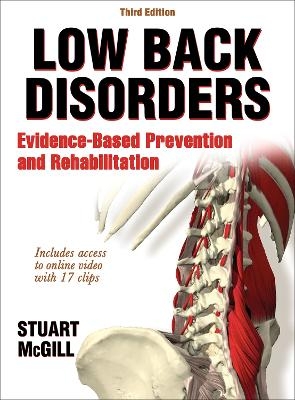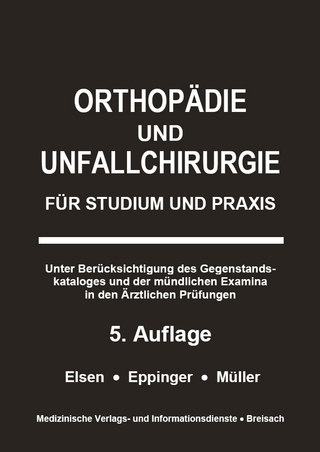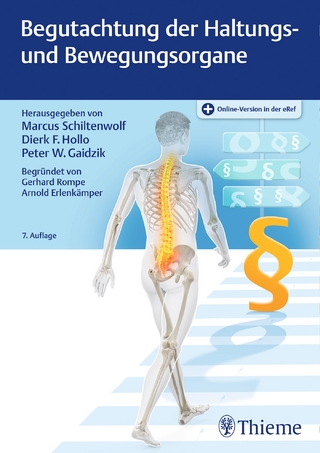
Low Back Disorders
Human Kinetics (Verlag)
978-1-4504-7291-3 (ISBN)
- Titel z.Zt. nicht lieferbar
- Versandkostenfrei innerhalb Deutschlands
- Auch auf Rechnung
- Verfügbarkeit in der Filiale vor Ort prüfen
- Artikel merken
Low Back Disorders, Third Edition With Web Resource, guides readers through the assessment and treatment of low back pain, providing evidence-based research on the best methods of rehabilitation and prevention of future injury. In this book, internationally recognized low back specialist Stuart McGill presents the research and applications of back anatomy and biomechanics to build effective prevention and rehabilitation programs for patients or clients.
This third edition of Low Back Disorders contains all of the essential tools for those with low back maladies. Strong foundational information on anatomy and injury mechanisms guide readers through the essential functions of the structures of the low back and related tissues, and common misconceptions about pain and discomfort are addressed and corrected. The text provides detailed insights into injury assessment by an extensively expanded set of tests with accompanying instructions. These provide guidance and recommendations for individualized rehabilitation strategies and exercises. Also new to this edition is a web resource featuring 20 fillable Handouts for Patients or Clients that can be edited and printed to suit practitioner and patients’ needs. The web resource also contains an online video suite that showcases various exercises and assessments. In addition to offering strategies for relieving and potentially eliminating pain, the text provides insight into the conditions and environments that may initially cause back pain and makes recommendations on reducing these influences so that clients can be pain free.
This book contains more than 500 photos, graphs, and charts on anatomy, biomechanics, and assessments; 50 tests and exercises with step-by-step instructions are available to aid readers in developing successful programs for patients and clients. In addition to the evidence-based foundation of this edition, the following enhancements have been made:
• Completely updated information and streamlined chapter organization ensure that practitioners use best clinical practices.
• Practical checklists throughout the text provide easy access to testing and assessment clinical techniques and information.
• Practical Applications provide clinical information to aid readers in understanding concepts and theory.
• To aid instructors, the text includes a newly added image bank to visually support class lectures.
Low Back Disorders, Third Edition With Web Resource, contains essential research and corresponding clinical applications in a clear and organized format. Part I introduces the functional anatomy and biomechanics of the lumbar spine. It also presents epidemiological studies on low back disorders and dispels common myths of lumbar spine stability. Part II reviews risk factors for low back disorders and common prevention methods, with specific attention paid to reducing workplace risk factors. Part III explains evaluating and diagnosing clients and developing exercise and rehabilitation programs. Specific exercises that are proven to enhance performance and reduce pain are also explained.
Evidence-based research and cutting-edge application strategies from a leading spine specialist in North America make Low Back Disorders, Third Edition With Web Resource, the authoritative text for the examination and rehabilitation of the low back. Its approach to back care will lead readers in developing intervention, rehabilitation, and prevention programs to address the unique needs of each patient or client.
Earn continuing education credits/units! A continuing education course and exam that uses this book is also available. It may be purchased separately or as part of a package that includes all the course materials and exam.
Stuart McGill, PhD, is a professor at the University of Waterloo, Ontario, Canada, and a world-renowned lecturer and expert in spine function, injury prevention, and rehabilitation. He has written more than 300 scientific publications on lumbar function, mechanisms of low back injury, investigation of rehabilitation programs matched to specific categories of back pain patients, and the formulation of work-related injury avoidance strategies. He has received several awards for his work, including the Volvo Bioengineering Award for Low Back Pain Research from Sweden. McGill has been an invited lecturer at many universities and delivered more than 300 addresses to societies around the world. As a consultant, he has provided expertise on assessment and reduction of the risk of low back injury to government agencies, corporations, professional athletes and teams, and legal firms. He is one of the few scientists who, in addition to performing research, is regularly requested by the medical profession to consult with challenging patients from around the world.
Part I Scientific Foundation
Chapter 1. Introduction to the Issues and Scientific Approach Unique to This Book
Legislative Landscape: The Unfortunate Adverse Impact on Painful Backs
Deficiencies in Current Diagnostic Practices
Inadequacies in Current Care and Prevention
Mechanical Loading and the Process of Injury: A Low Back Tissue Injury Primer
Excellent Clinicians and Excellent Practice
Unique Scientific Foundation of This Book
In Vitro Lab
In Vivo Lab
A Final Note
Chapter 2. Epidemiological Studies and What They Really Mean
Influence of Randomized Controlled Trials and Other Epidemiological Approaches
Misunderstandings of Epidemiology
Multidimensional Links Among Biomechanical, Psychosocial, and Personal Variables
Are Biomechanical Variables and Psychosocial Variables Distinct?
How Do Biomechanical Factors Affect LBD?
Links Between Personal Factors and LBD
Studies of Exercise Intervention
Practical Application: What the Evidence Supports
What Works Clinically
A Final Note
Chapter 3. Functional Anatomy of the Lumbar Spine
Anatomy Trains
Basic Neural Structure
Vascular Anatomy
Vertebrae
Sacroiliac Joints
Intervertebral Disc
Muscles
Ligaments
Lumbodorsal Fascia (LDF)
Quick Review of the Pelvis, Hips, and Related Musculature
Clinically Relevant Aspects of Pain and Anatomic Structure
A Final Note
Chapter 4. Normal and Injury Mechanics of the Lumbar Spine
Kinematic Properties of the Thoracolumbar Spine
Kinetics and Normal Lumbar Spine Mechanics
Dubious Lifting Mechanisms
Other Important Mechanisms of Normal Spine Mechanics
Injury Mechanisms
Biomechanical and Physiological Changes Following Injury
A Final Note
Chapter 5. Myths and Realities of Lumbar Spine Stability
Why Spine Stability Is Important for Everyone
Stability: A Qualitative Analogy
Quantitative Foundation of Stability
Stability Myths, Facts, and Clinical Implications
A Final Note
Part II Injury Prevention
Chapter 6. LBD Risk Assessment
Brief Review of the Risk Factors for LBD
NIOSH Approach to Risk Assessment
Snook Psychophysical Approach
Lumbar Motion Monitor (LMM)
Ergowatch
Biological Signal–Driven Model Approaches
A Final Note
Chapter 7. Reducing the Risk of Low Back Injury
Lessons From the Literature
LBD Prevention for Workers
The Question of Back Belts
LBD Prevention for Employers
Injury Prevention Primer
A Note for Consultants
Reducing the Risk in Athletes
A Final Note
Part III Low Back Rehabilitation
Chapter 8. Building Better Rehabilitation Programs for Low Back Injuries
Pain-Reducing Mechanisms of Exercise
Five-Stage Back Training Program
Finding the Best Approach
Stages of Patient Progression
Guidelines for Developing the Best Exercise Regimen
A Final Note
Chapter 9. Evaluating the Patient
Most Crucial Element in Evaluation
First Clinician–Patient Meeting
Assessing Posture and Movement Quality
Some Provocation Tests
Some Functional Screens
Testing Muscle Endurance
A Final Note
Chapter 10. Developing the Exercise Program
Philosophy of Low Back Exercise Design
Clinical Wisdom
Thoughts on Mobility
Identifying Safe and Effective Exercises
Beginner’s Program for Pain Control and Stabilization
Exercises That May Be Used in a Stabilization Program
Special Conditions
A Final Note
Chapter 11. Advanced Exercises
Safely Increasing Challenges
Occupational and Athletic Work Hardening
A Final Note
| Verlagsort | Champaign, IL |
|---|---|
| Sprache | englisch |
| Maße | 216 x 279 mm |
| Gewicht | 1429 g |
| Themenwelt | Medizinische Fachgebiete ► Chirurgie ► Unfallchirurgie / Orthopädie |
| Medizin / Pharmazie ► Medizinische Fachgebiete ► Schmerztherapie | |
| Medizin / Pharmazie ► Medizinische Fachgebiete ► Sportmedizin | |
| Medizin / Pharmazie ► Physiotherapie / Ergotherapie | |
| ISBN-10 | 1-4504-7291-5 / 1450472915 |
| ISBN-13 | 978-1-4504-7291-3 / 9781450472913 |
| Zustand | Neuware |
| Haben Sie eine Frage zum Produkt? |
aus dem Bereich


